Hells Angels
The Hells Angels Motorcycle Club (HAMC) is a worldwide one-percenter motorcycle club whose members typically ride Harley-Davidson motorcycles.
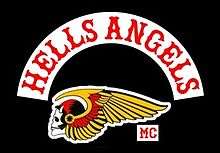 | |
| Motto | "Angels Forever, Forever Angels" (traditional)[1] "When we do right, nobody remembers. When we do wrong, nobody forgets." (unspecific, one-percenter saying)[2] |
|---|---|
| Founded | March 17, 1948[3] |
| Location | San Bernardino, California, United States[4] |
| Founder | Otto Friedli[3] |
| Leader title | National President |
| Key people | Sonny Barger |
| Type | Outlaw motorcycle club |
| Region | Worldwide (467 chapters in 59 countries)[5] |
| Website | www.hells-angels.com |
| Abbreviation | HA, 81, HAMC |
In May 2019, a court in Utrecht issued a verdict that made the Netherlands the first country to completely ban the Hells Angels; other countries such as Germany had banned local chapters, but never before the entire club.[6][7][8][9] The United States Department of Justice considers the club to be an organized crime syndicate.[10][11][12][13] In the United States and Canada, the Hells Angels are incorporated as the Hells Angels Motorcycle Corporation. Common nicknames for the club are the "H.A.", "Red & White", "HAMC", and "81".[14][15]
History
The Hells Angels originated on March 17, 1948 in Fontana, California, when several small motorcycle clubs agreed to merge.[16] If the Hells Angels' own website is to be believed,[17] the received suggestion is unfounded that the former troops to join the club included misfits and malcontents. The website also notes that the name was first suggested by an associate of the founders named Arvid Olsen, who had served in the "Hell's Angels" squadron of the Flying Tigers in China during World War II.[18] It is at least clear that the name was inspired by the tradition from World Wars I and II whereby the Americans gave their squadrons fierce, death-defying titles; an example of this lies in one of the three P-40 squadrons of Flying Tigers fielded in Burma and China, which was dubbed "Hell's Angels".[19] In 1930, the Howard Hughes film Hell's Angels showcased extraordinary and dangerous feats of aviation, and it is believed that the World War II groups who used that name based it on the film. According to the Hells Angels' website, they are aware that there is an apostrophe missing in "Hell's", but state that, "...it is you who miss it. We don't".[20]
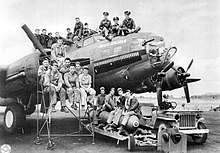
Some of the early history of the HAMC is not clear, and accounts differ. According to Ralph "Sonny" Barger, founder of the Oakland charter, early charters of the club were founded in San Francisco, Gardena, Fontana, Oakland and elsewhere, with the members usually being unaware that there were other clubs. One of the lesser-known clubs existed in North Chino/South Pomona, in the late 1960s.
Other sources claim that the Hells Angels in San Francisco were organized in 1953 by Rocky Graves, a Hells Angel member from San Bernardino ("Berdoo"), implying that the "Frisco" Hells Angels were very much aware of their forebears.[23] The "Frisco" Hells Angels were reorganized in 1955 with thirteen charter members, Frank Sadilek serving as president, and using the smaller, original logo. The Oakland charter, at the time headed by Barger, used a larger version of the "Death's Head" patch nicknamed the "Barger Larger", which was first used in 1959. It later became the club standard.
The Hells Angels are often depicted in semi-mythical romantic fashion like the 19th-century James–Younger Gang: free-spirited, iconic, bound by brotherhood and loyalty. At other times, such as in the 1966 Roger Corman film The Wild Angels, they are depicted as violent and nihilistic, little more than a violent criminal gang and a scourge on society.[24]
The club became prominent within, and established its notoriety as part of the 1960s counterculture movement in San Francisco's Haight-Ashbury scene, playing a part at many of the movement's seminal events. Members were directly connected to many of the counterculture's primary leaders, such as Ken Kesey and the Merry Pranksters, Allen Ginsberg, Jerry Garcia and the Grateful Dead, Timothy Leary, The Beatles, The Rolling Stones, Mick Farren, and Tom Wolfe. Writing a book about the club launched the career of "Gonzo" journalist Hunter S. Thompson.[25][26][27][28]
In 1973, members from several branches of the organization protested at an Environmental Protection Agency hearing about a proposed transportation plan that included restrictions on motorcycle use and sales to get California to meet the new Clean Air Act standards.[29]
Criminal activities and incidents
Numerous police and international intelligence agencies classify the Hells Angels as one of the "big four" motorcycle clubs, along with the Pagans, Outlaws, and Bandidos, and contend that members carry out widespread violent crime and organized crime, including drug dealing, trafficking in stolen goods, and extortion, and are involved in prostitution.[30][31] Members of the organization have continuously asserted that they are only a group of motorcycle enthusiasts who have joined to ride motorcycles together, to organize social events such as group road trips, fundraisers, parties, and motorcycle rallies, and that any crimes are the responsibility of the individuals who carried them out and not the club as a whole.[32][33]
On May 29, 2019, the Hells Angels were banned in the Netherlands. This is the first country in the world to outlaw the entire club. The presiding judge of the court in Utrecht called it "a danger to public order and the rule of law".[34]
Insignia
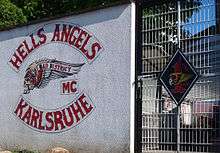
The Hells Angels' official website attributes the official "death's head" insignia design to Frank Sadilek, past president of the San Francisco charter.[35] The colors and shape of the early-style jacket emblem (prior to 1953) were copied from the insignias of the 85th Fighter Squadron and the 552nd Medium Bomber Squadron.[35]
The Hells Angels utilize a system of patches similar to military medals. Although the specific meaning of each patch is not publicly known, the patches identify specific or significant actions or beliefs of each biker.[36] The official colors of the Hells Angels are red lettering displayed on a white background—hence the club's nickname "The Red and White". These patches are worn on leather or denim jackets and vests.
Red and white are also used to display the number 81 on many patches, as in "Support 81, Route 81". The 8 and 1 stand for the respective positions in the alphabet of H and A. These are used by friends and supporters of the club in deference to club rules, which purport to restrict the wearing of Hells Angels imagery to club members. The diamond-shaped one-percenter patch is also used, displaying '1%' in red on a white background with a red merrowed border. The term one-percenter is said to be a response to the American Motorcyclist Association (AMA) comment on the Hollister incident, to the effect that 99% of motorcyclists were law-abiding citizens and the last 1% were outlaws. The AMA has no record of such a statement to the press, and calls this story apocryphal.[37]
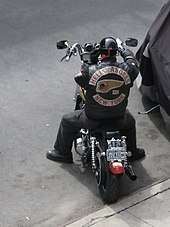
Most members wear a rectangular patch (again, white background with red letters and a red merrowed border) identifying their respective charter locations. Another similarly designed patch reads "Hells Angels". When applicable, members of the club wear a patch denoting their position or rank within the organization. The patch is rectangular and, similar to the patches described above, displays a white background with red letters and a red merrowed border. Some examples of the titles used are President, Vice President, Secretary, Treasurer, and Sergeant at Arms. This patch is usually worn above the 'club location' patch. Some members also wear a patch with the initials "AFFA", which stands for "Angels Forever; Forever Angels", referring to their lifelong membership in the biker club (i.e., "once a member, always a member").
The book Gangs, written by Tony Thompson (a crime correspondent for The Observer), states that Stephen Cunningham, a member of the Angels, sported a new patch after he recovered from attempting to set a bomb, consisting of two Nazi-style SS lightning bolts below the words 'Filthy Few'. Some law enforcement officials claim that the patch is only awarded to those who have committed or are prepared to commit murder on behalf of the club. According to a report from the R. v. Bonner and Lindsay case in 2005 (see related section below), another patch, similar to the 'Filthy Few' patch is the 'Dequiallo' patch. This patch "signifies that the wearer has fought law enforcement on arrest."[38] There is no common convention as to where the patches are located on the members' jacket/vest.
Intellectual property rights
According to The Globe and Mail the Hells Angels considered seeking an injunction to block the Canadian Broadcasting Corporation from broadcasting the miniseries The Last Chapter, because of how closely the biker gang at the center of the series resembled the Hells Angels.[39]
In March 2007 the Hells Angels filed suit against the Walt Disney Motion Pictures Group alleging that the film entitled Wild Hogs used both the name and distinctive logo of the Hells Angels Motorcycle Corporation without permission.[40] The suit was eventually voluntarily dismissed,[41] after the Angels received assurances from Disney that the references would not appear in the film.[42]
On October 7, 2009, Fritz Clapp, attorney at law for the Hells Angels Motorcycle Corporation, contacted online games community FOCO, demanding the removal of all membership marks and club trademarks from the Los Santos Roleplay Forum. While the members of the community were skeptical at first, Fritz Clapp posted a tweet confirming his identity.[43][44]
In October 2010 the Hells Angels filed a lawsuit against Alexander McQueen for "misusing its trademark winged death heads symbol"[45] in several items from its Autumn/Winter 2010 collection. The lawsuit is also aimed at Saks Fifth Avenue and Zappos.com, which stock the jacquard box dress and knuckle duster ring that bear the symbol, which has been used since at least 1948 and is protected by the U.S. Patent and Trademark Office. A handbag and scarf was also named in lawsuit.[46] The lawyer representing Hells Angels claimed: "This isn't just about money, it's about membership. If you've got one of these rings on, a member might get really upset that you're an impostor."[47] Saks refused to comment, Zappos had no immediate comment and the company's parent company, PPR, could not be reached for comment.[48] The company settled the case with the Hells Angels after agreeing to remove all of the merchandise featuring the logo from sale on their website, stores and concessions and recalling any of the goods that have already been sold and destroying them.[49][50][51]
In fall 2012 in the United States District Court for the Eastern District of California, Hells Angels sued Toys "R" Us for trademark infringement, unfair competition, and dilution in relation to the sale of yo-yos manufactured by Yomega Corporation, a co-defendant, which allegedly bear the "Death Head" logo. In its complaint,[52] Hells Angels asserted that the mark used on the yo-yos is likely to confuse the public into mistakenly believing that the toys originate with Hells Angels and Yomega filed counterclaims against Hells Angels for cancellation of the "Death Head" registrations on grounds of alleged fraud in the procurement of the registrations.[53] The case settled and the lawsuit was dismissed with prejudice.
As of December 2013, the Hells Angels sells its branded merchandise at a retail store in Toronto, Canada.[54]
Membership
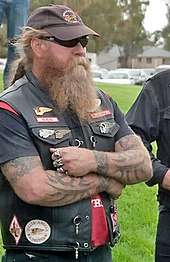
In order to become a Hells Angels prospect, candidates must have a valid driver's license, a motorcycle over 750cc, and have the right combination of personal qualities. It is said the club excludes child molesters and individuals who have applied to become police or prison officers.[55]
After a lengthy, phased process, a prospective member is first deemed to be a "hang-around", indicating that the individual is invited to some club events or to meet club members at known gathering places.
If the hang-around is interested, he may be asked to become an "associate", a status that usually lasts a year or two. At the end of that stage, he is reclassified as "prospect", participating in some club activities, but not having voting privileges while he is evaluated for suitability as a full member. The last phase, and highest membership status, is "Full Membership" or "Full-Patch".[56] The term "Full-Patch" refers to the complete four-piece insignia, including the "Death Head" logo, two rockers (top rocker: "Hells Angels"; bottom rocker: state or territory claimed) and the rectangular "MC" patch below the wing of the Death's Head. Prospects are allowed to wear only a bottom rocker with the state or territory name along with the rectangular "MC" patch.
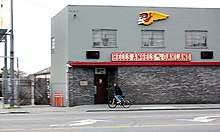
To become a full member, the prospect must be voted on unanimously by the rest of the full club members.[57] Prior to votes being cast, a prospect usually travels to every charter in the sponsoring charter's geographic jurisdiction (state/province/territory) and introduces himself to every Full-Patch member. This process allows each voting member to become familiar with the subject and to ask any questions of concern prior to the vote. Some form of formal induction follows, wherein the prospect affirms his loyalty to the club and its members. The final logo patch (top "Hells Angels" rocker) is then awarded at this initiation ceremony. The step of attaining full membership can be referred to as "being patched".
Even after a member is patched in, the patches themselves remain the property of HAMC rather than the member. On leaving the Hells Angels, or being ejected, they must be returned to the club.[58]
Worldwide charters
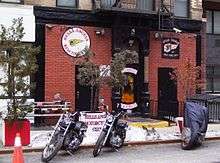
The HAMC acknowledges more than a hundred charters spread over 29 countries. The Hells Angels motorcycle club founded a charter in Auckland, New Zealand, in 1961 and has since taken over gangs in Wanganui. New Zealand had the first charter of the Hells Angels outside the United States.[59] Europe did not become widely home to the Hells Angels until 1969 when two London charters were formed. The Beatles' George Harrison invited some members of the HAMC San Francisco to stay at Apple Records in London in 1968.[60][61] According to Chris O'Dell, only two members showed up at Apple Records, Frisco Pete and Bill "Sweet William" Fritsch.[62] Two people from London visited California, "prospected", and ultimately joined. Two charters were issued on July 30, 1969; one for "South London"—the re-imagined charter renewing the already existing 1950 South London charter—and the other for "East London", but by 1973 the two charters came together as one, called "London". The London Angels provided security at a number of UK Underground festivals including Phun City in 1970 organized by Mick Farren. They awarded Farren an "approval patch" in 1970 for use on his first solo album Mona, which also featured Steve Peregrin Took (who was credited as "Shagrat the Vagrant").[63]
In the 1980s and 1990s, there was a major expansion of the club into Canada. The Quebec Biker war was a violent turf war that began in 1994 and continued until late 2002 in Montreal. The war began as the Hells Angels in Quebec began to make a push to establish a monopoly on street-level drug sales in the province. A number of drug dealers and crime families resisted and established groups such as the "Alliance to fight the Angels". The war resulted in the bombings of many establishments and murders on both sides. It has claimed more than 150 lives[64] and led to the incarceration of over 100 bikers.[65]
Members of the Spanish Charter were involved in a killing and tried.[66]
A list of acknowledged charters can be found on the HAMC's official website.[67]
Racial policies
The club claims not to be a racially segregated organization,[68][69] although at least one charter allegedly requires that a candidate be a white male,[70] and Sonny Barger stated in a BBC interview in 2000 that "The club, as a whole, is not racist but we probably have enough racist members that no black guy is going to get in it."[57] At that time the club had no black members.[57]
However, there have been black members of puppet clubs, notably Gregory Woolley, a high-ranking member of the Rockers MC in Montreal who was the protégé[71] and bodyguard of Hells Angel boss Maurice Boucher (who spent five years in a notoriously white-supremacist motorcycle gang, the SS). Woolley became an associate of the Hells Angels Montreal charter[72] in the 1990s and later tried uniting street gangs in Quebec after Boucher was imprisoned.[73]
In another interview with leader Sonny Barger in 2000 he remarked "if you're a motorcycle rider and you're white, you want to join the Hell's Angels. If you black, you want to join the Dragons. That's how it is whether anyone likes it or not. We don't have no blacks and they don't have no whites."[74] When asked if that could change Barger replied "Anything can change, I can't predict the future."[74] Tobie Levingston who formed the black motorcycle club East Bay Dragons MC wrote in his book that he and Sonny Barger have a long-lasting friendship and that the Hells Angels and Dragons have a mutual friendship and hang out and ride together.[75]
In a 1966 article about motorcycle rebels in the African-American community magazine Ebony, the Chosen Few MC stated that they see no racial animosity in the Hells Angels and that when they come into Chosen Few territory they all get together and just party.[76] A Hells Angel member interviewed for the magazine insisted there was no racial prejudice in any of their clubs and stated "we don't have any negro members" but maintained there have not been any blacks who have sought membership.[76] At one point in the 1970s the Hells Angels were looking to consolidate the different motorcycle clubs and offered every member of the Chosen Few MC a Hells Angel badge, but the Chosen Few turned down the offer.[77]
See also
References
- Frank Reynolds, Michael McClure (1967). Freewheelin Frank: Secretary of the Angels, Grove Press, 1967, p. 73
- Hopper, C. B., & Moore, J. (1990). "Women in outlaw motorcycle gangs". Journal of Contemporary Ethnography, 18(4), p. 385.
- "Inside the biker gangs: the truth about guns, drugs and organized crime". The Independent. UK. August 14, 2007. Archived from the original on June 9, 2008. Retrieved August 13, 2010.
- Drewery, George (Spring 2003). "3 Skulls, Wings & Outlaws – Motorcycle Club Insignia & Cultural Identity" (PDF). Inter-Cultural Studies; A Forum on Social Change & Cultural Diversity. 3 (2). p. 29. ISSN 1445-1190. Archived from the original (PDF) on September 6, 2006.
- http://www.hells-angels.com At the bottom of the homepage under "CHARTERS WORLDWIDE" is a listing of all current info - continents, countries, areas and charters
- "Netherlands first country to ban the Hells Angels; Violence called "systemic", "common"". NL Times. May 29, 2019.
- "Hells Angels bikers banned by Dutch court". May 29, 2019 – via www.bbc.com.
- France-Presse, Agence (May 29, 2019). "Hells Angels banned by Dutch court in biker gang crackdown" – via www.theguardian.com.
- "Dutch court bans 'violent' Hells Angels motorcycle club". May 29, 2019 – via www.reuters.com.
- "Motorcycle gang". U.S. Department of Justice. Archived from the original on April 15, 2014. Retrieved January 23, 2010.
- Lockyer, Bill (2003). "ORGANIZED CRIME IN CALIFORNIA" (PDF). CALIFORNIA DEPARTMENT OF JUSTICE. Archived from the original (PDF) on January 29, 2010. Retrieved January 23, 2010.
- "ORGANIZED CRIME IN OREGON" (PDF). Oregon State Department of Justice. September 2006. Archived from the original (PDF) on July 21, 2011. Retrieved January 23, 2010.
- "ASIAN ORGANIZED CRIME AND TERRORIST ACTIVITY IN CANADA, 1999–2002" (PDF). Federal Research Division. Library of Congress. July 2003. Retrieved January 23, 2010.
- "81" is a metonym. As 'H' and 'A' are the 8th and 1st letter of the alphabet.
- "Hells Angels MC World FAQ". Hells-angels.com. Retrieved March 27, 2012.
- The Secret Life of Bikers by Jerry Langton. Location 19.5/477. HarperCollings:2018 ISBN 978-1-44345-467-4
- "Hels Angels Motorcycle Club World". hells-angels.com. Retrieved November 30, 2014.
- "Hells Angels MC World". Hells-angels.com. Retrieved February 15, 2011.
- Rossi, J.R. "Flying Tiger Association Unit Rosters". The Flying Tigers - American Volunteer Group - Chinese Air Force.
- Hells Angels FAQ
- Bishop, Cliff T. (1986). Fortresses of the Big Triangle First, East Anglia Books. ISBN 1-869987-00-4, pp.160, 236.
- "Hells Angels vs. Memphis Belle, Historical Information" (PDF). 303rd Bomb Group Association. Retrieved August 11, 2008.
- Birney Jarvis for Male magazine, 1964. Reprinted in Hells Angels by Hunter S. Thompson
- Bagnall, Sam (January 2, 2004). "Hells Angels: Easy-riders or criminal gang?". This World. BBC News. Retrieved August 13, 2010.
- "The Fall of the Counterculture : Preview". Bu.digication.com. Retrieved November 30, 2014.
- Hell's Angels and the Illusion of the Counterculture; Wood, John. 30 Sept 2003. The Journal of Popular Culture, Volume 3
- The Haight-Ashbury: A History; Perry, Charles. 2005
- "Interview with Sonny Barger". Pdr.autono.net. Archived from the original on July 30, 2012. Retrieved June 18, 2013.
- "Early Implementation of the Clean Air Act of 1970 in California". EPA Alumni Association. Video, Transcript (see p. 14). July 12, 2016.
- "FBI Safe Street Violent Crime Initiative Report Fiscal Year 2000" (PDF). Archived from the original (PDF) on September 13, 2001. Retrieved August 13, 2010.
- Ibrahim, Youssef M. (March 3, 1997). "New York Times, Sweden's Courteous Police Spoil a Hell's Angels Clubouse Party". New York Times. Stockholm (Sweden); Sweden. Retrieved August 13, 2010.
- "[Hpn] Hells Angels Mc Salvation Army Shelter Run". Hpn.asu.edu. July 6, 2003. Archived from the original on July 9, 2010. Retrieved August 9, 2010.
- "Under watchful eye, bikers aid charity – Thursday, Sept. 4, 2008 | midnight". Las Vegas Sun. Retrieved August 9, 2010.
- "Hells Angels bikers banned by Netherlands court". BBC. May 29, 2019. Retrieved May 30, 2019.
- "History". Hells-angels.com. Archived from the original on July 14, 2008.
- Gangs; A Journey into the heart of the British Underworld, Tony Thompson, (2004) ISBN 0-340-83053-0
- Lindsey, Tom (November 2005). "A Brief History of "Outlaw" Motorcycle Clubs". International Journal of Motorcycle Studies.
The Life story caused something of a tumult around the country (Yates), and some authors have asserted that the AMA subsequently released a press statement disclaiming involvement in the Hollister event, stating that 99% of motorcyclists are good, decent, law-abiding citizens and that the AMA's ranks of motorcycle clubs were not involved in the debacle (e.g., Reynolds, Thompson). However, the American Motorcyclist Association has no record of ever releasing such a statement. Tom Lindsay, the AMA's Public Information Director, states 'We [the American Motorcyclist Association] acknowledge that the term 'one-percenter' has long been (and likely will continue to be) attributed to the American Motorcyclist Association, but we've been unable to attribute its original use to an AMA official or published statement—so it's apocryphal.'
- HAMC Overview Document, Overview of the Hell's Angel's Motorcycle Club (HAMC) In Canada
-
Ray Conlogue (March 2, 2002). "Bilingual on bikes". The Globe and Mail. Retrieved July 18, 2020.
If you're a TV show and the Hells Angels are considering a court injunction to stop you from being broadcast, then that's what you'll be famous for.
- 'Litigation against movie release' (March 8, 2006) and they rule., HAMC vs Walt Disney
- "Hells Angels Motorcycle Club settled disputes the old-fashioned way, with a swift kick in the groin or a punch in the face to the offending party. – Hells Angels". Zimbio. Archived from the original on July 18, 2011. Retrieved February 15, 2011.
- "Companies / Personal Goods – Hells Angels sue luxury fashion house". Financial Times. October 27, 2010. Retrieved February 15, 2011.
- zzfritz, Fritz Clapp (October 7, 2009). "Re: Hell's Angels skinpack". FOFO Gaming. Retrieved October 7, 2009.
- zzfritz, Fritz Clapp (October 7, 2009). "Fritz Clapp Tweet". Twitter. Retrieved October 7, 2009.
- Ella Alexander (October 27, 2010). "Hells Angels sue Alexander McQueen (Vogue.com UK)". Vogue.co.uk. Archived from the original on October 30, 2010. Retrieved February 15, 2011.
- "Companies / Personal Goods – Hells Angels sue luxury fashion house". Financial Times. October 27, 2010. Retrieved February 15, 2011.
- "Hells Angels set for rumble on the catwalk - Business - Retail". NBC News. October 27, 2010. Retrieved February 15, 2011.
- Jeffrey, Don (October 26, 2010). "Hells Angels Sue Saks, McQueen Design, Over Trademark". Bloomberg. Retrieved February 15, 2011.
- "Grazia Fashion: McQueen Settles with Hells Angels". Graziadaily.co.uk. Retrieved February 15, 2011.
- Verena von Pfetten (November 3, 2010). "Alexander McQueen – Hell's Angels – SETTLEMENT". Styleite. Retrieved February 15, 2011.
- Cowles, Charlotte. "Alexander McQueen Settles With Hells Angels by Agreeing to Destroy Merchandise With Skull Logo – The Cut". Nymag.com. Retrieved February 15, 2011.
- "Attorney for Plaintiff : HELLS ANGELS MOTORCYCLE CORPORATION" (PDF). Archive.org. Retrieved November 30, 2014.
- Weller, Susan Neuberger (July 12, 2013). "Hells Angels and Toys "R" Us Settle "Death Head" Trademark Litigation". The National Law Review.
- Weiss, Debra Cassens (December 3, 2013). "Hells Angels club sues often to protect its intellectual property". ABA Journal. Retrieved December 30, 2013.
- Hall, Neal (June 10, 2005). "Behind the Patch: Angels ABCs". The Vancouver Sun. Archived from the original on March 3, 2010. Retrieved August 13, 2010.
- NDIC Document, US Department of Justice Report on OMG HA
- "Born to raise Hell". BBC News. August 14, 2000. Retrieved February 1, 2013.
- A Wayward Angel: The Full Story of the Hells Angels by George Wethern and Vincent Colnett
- Kemp, p 50
- "George Harrison's memo to Apple staff about the Hell's Angels, 4 December 1968". Beatlesbible.com. December 4, 1968. Retrieved November 6, 2013.
- Pg. 129, Rock Scully, David Dalton, "Living with the Dead: Twenty Years on the Bus with Garcia and the Grateful Dead", Cooper Square Publ Inc, 2001 ISBN 978-0-8154-1163-5
- Chris O'Dell (October 6, 2009). Miss O'Dell: My Hard Days and Long Nights with The Beatles, The Stones, Bob Dylan, Eric Clapton, and the Women They Loved. Simon and Schuster. p. 68. ISBN 1416590935.
george harrison hell's angels.
- "Hells Angels MC London History". Archived from the original on May 9, 2009.
- "Biker gangs in Canada". Cbc.ca. July 13, 2011. Retrieved November 30, 2014.
- Archived February 8, 2009, at the Wayback Machine
- "Condenados nueve motoristas de los "Ángeles del Infierno" a 67 años de prisión". abc (in Spanish). January 14, 2014. Retrieved June 26, 2019.
- "Hells Angels MC World". Hells-angels.com. Archived from the original on January 9, 2015. Retrieved February 15, 2011.
- Johnson Publishing Company (December 1966). "Nazi Emblems of 'Way Outs' Are No Symbols of Hate". Ebony. p. 70. ISSN 0012-9011.
- 2003 Soul on Bikes: The East Bay Dragons MC and Black Biker Set, Tobie Gene Levingston, with Keith and Kent Zimmerman (St. Paul, MN: Motorbikes International Publishing). The history of the Oakland-based African-American Motorcycle Club with a foreword from Sonny Barger.
- Wright, Gary L. (June 8, 2012). "FBI leads crackdown on area Hells Angels gangs in N.C. and S.C." Winston-Salem Journal. Archived from the original on June 19, 2017. Retrieved June 18, 2013.
- Eric Thibault (August 16, 2012). "Sun News : Dead gang leader rebuffed top biker prior to assassination: Source". Sunnewsnetwork.ca. Archived from the original on January 7, 2013. Retrieved June 18, 2013.
- "Montreal police try to calm mafia war fears after multiple killings". Global Montreal. Archived from the original on March 23, 2013. Retrieved June 18, 2013.
- Giuseppe Valiante. "Sun News : Bust shows connections in criminal underworld in Canada". Sunnewsnetwork.ca. Archived from the original on November 3, 2012. Retrieved June 18, 2013.
- "Sonny Barger Interview". Let Them Talk. Archived from the original on July 30, 2012. Retrieved June 18, 2013.
- "Soul on Bikes: Tobie Levingston: 9780760317471: Amazon.com: Books". Amazon.com. Retrieved June 18, 2013.
- Johnson Publishing Company (December 1966). "Nazi Emblems of 'Way Outs' Are No Symbols of Hate". Ebony. p. 66. ISSN 0012-9011.
- "Chosen Few Motorcycle Club - Buffalo, NY". Chosenfewbuffalony.com. Archived from the original on May 25, 2013. Retrieved June 18, 2013.
Further reading
- Sonny Barger (2009). Hell's Angel: The Autobiography of Sonny Barger. HarperCollins. ISBN 978-0-06-184736-3.
- Paul Cherry (2005). The Biker Trials: Bringing Down the Hells Angels. ECW Press. ISBN 978-1-55490-250-7.
- Jerry Langton (2009). Fallen Angel: The Unlikely Rise of Walter Stadnick and the Canadian Hells Angels. John Wiley & Sons. ISBN 978-0-470-73994-5.
- Yves Lavigne (2000). Hell's Angels: Taking Care of Business. Random House of Canada, Limited. ISBN 978-0-7704-2858-7.
- Yves Lavigne (2011). Hells Angels: Into the Abyss. HarperCollins Publishers Limited. ISBN 978-1-4434-0411-2.
- Yves Lavigne (2011). Hell's Angels at War. HarperCollins Publishers Limited. ISBN 978-1-4434-0410-5.
- William Marsden; Julian Sher (2010). Angels of Death: Inside the Bikers' Empire of Crime. Knopf Canada. ISBN 978-0-307-37032-7.
- Valerie Smart (2001). The Original Hell's Angels: 303rd Bombardment Group of World War II. Arcadia Publishing. ISBN 978-0-7385-0910-5.
- Julian Sher; William Marsden (2010). The Road to Hell: How the Biker Gangs are Conquering Canada. Knopf Canada. ISBN 978-0-307-36586-6.
- Carter F. Smith (2017). Gangs and the Military: Gangsters, Bikers, and Terrorists with Military Training. Rowman & Littlefield.
- Hunter S. Thompson (1999). Hell's Angels: A Strange and Terrible Saga. Modern Library. ISBN 978-0-679-60331-3.
- Edward Winterhalder; Wil De Clercq (2008). The Assimilation: Rock Machine Become Bandidos: Bikers United Against the Hells Angels. ECW Press. ISBN 978-1-55490-321-4.
External links
| Wikimedia Commons has media related to Hells Angels. |
- Official website – includes many chartered local charters, with links
- Hells Angels at Curlie
- FBI file on Hell's Angels
- Never-Seen: Hells Angels, 1965 – slideshow by Life magazine